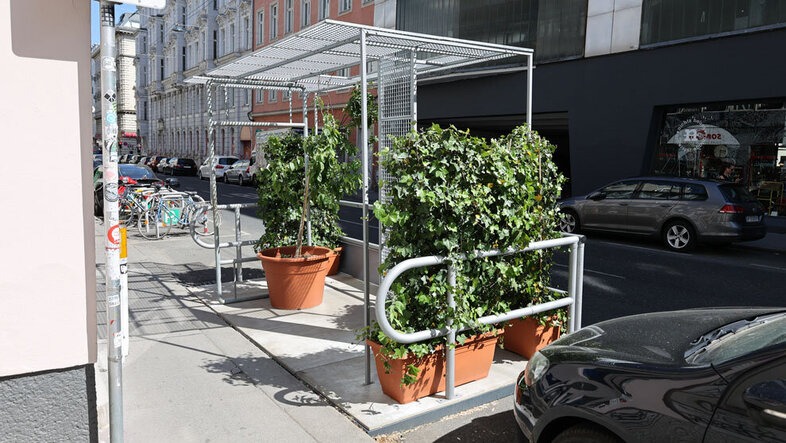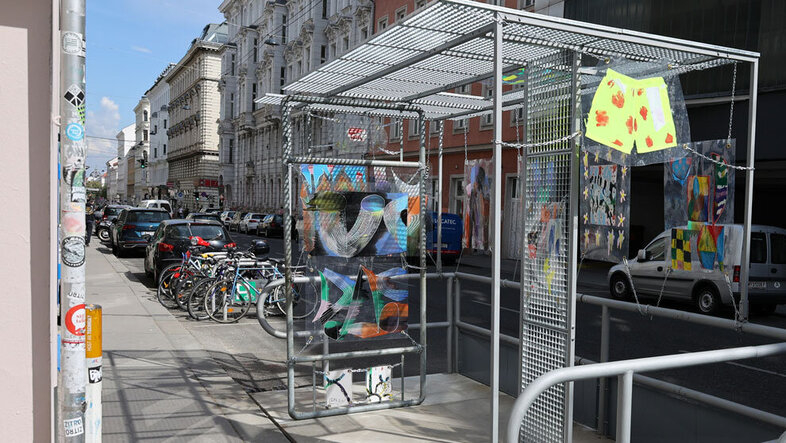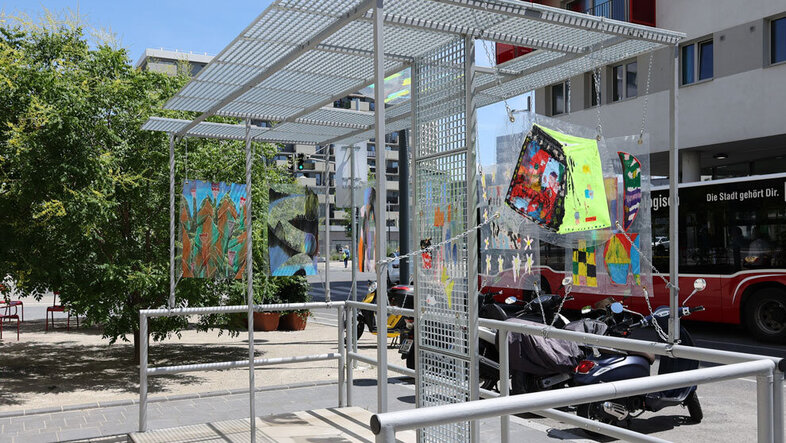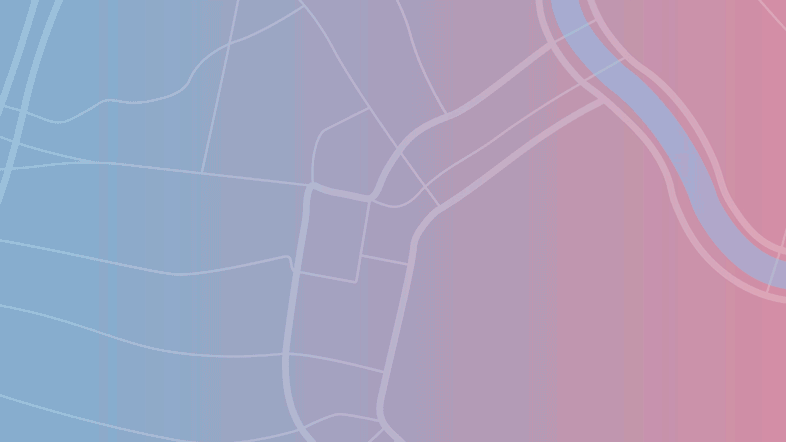The art of urban well-being
The 48A bus whizzes by, the concrete trembles: We are in the middle of Burggasse street, “an absolute traffic nightmare”, smirks behavioural biologist Elisabeth Oberzaucher. Yet it is here that cafes, shops and galleries are all lined up side by side. The seventh Viennese district is in vogue and is still considered one of the city’s most coveted neighbourhoods. But why do we actually feel so comfortable here?
In order to answer this question, Elisabeth Oberzaucher teamed up with psychologist Helmut Leder, who primarily focuses on empirical aesthetics. Together, they decorate some of the "Grätzloasen" (neighbourhood oases) all around the city: sometimes with plants, sometimes with art. Their aim is to investigate the effect of these interventions on our well-being. It is well established through numerous studies that greenery benefits us. Now the research duo is demonstrating that art — which is ubiquitous in Vienna's Neubau district — can have a similar effect in their current project "Urban Intervention with Art in Public Space."
We set out to visit their temporary urban laboratories: We start at Burggasse street, house number 98, which is home to an eponymous artists' collective that helped to develop the mobile Grätzloasen. We end our tour at Seestadt Aspern, where lots of greenery and open space boost our well-being. In the interview, the behavioural biologist Elisabeth Oberzaucher talks about their current project and why art is just as good for us as greenery — even when we do not find it particularly beautiful.
Rudolphina: Ms. Oberzaucher, how did you and Helmut Leder come up with the idea to compare artworks with, to put it bluntly, trees?
Elisabeth Oberzaucher: We know that urban greenery is crucial when it comes to the mental well-being of humans, but it also has its limits since we cannot plant trees everywhere. But artistic elements are part of the city landscape as well and that is why we asked ourselves: Can art exert similar positive effects as greenery?
I have studied the effect of plants on people before - I am the expert in the "green realm", so to speak, and Helmut Leder is the art expert. We agreed to tackle the research question in the public space, that is, in the field. For this purpose, we searched for artistic partners. In the end, we worked with the team Burggasse 98. This collective has been creating artistic interventions in public space for a long time and was very interested in finding out if their works actually have demonstrable effects on humans.
Come along on our Summer City Trip!
The Grätzloasen (neighbourhood oasis) spots from the project by Elisabeth Oberzaucher and Helmut Leder are decorated only temporarily, but if you want to experience the interplay between greenery, art and well-being, you can do so during a stroll near the University of Vienna, which will boost your happiness:
- Arcaded Courtyard of the University of Vienna: Especially on hot summer days, the Arcaded Courtyard in the Main Building serves as a green oasis, which is also home to contemporary art: Since 2016, you can view seven new artworks in honour of female academics in the Arcaded Courtyard at the University of Vienna, in addition to the 154 busts and commemorative plaques that are currently exclusively dedicated to men. The artists Thomas Baumann, Catrin Bolt and Karin Frank bring to the fore seven female academics in their projects, including the first female professor at the University of Vienna, the physicist Berta Karlik.
- Café in the Arcaded Courtyard: Next, you can enjoy a coffee or an ice cream (Opening hours: Monday to Friday: 8:00 to 18:00).
- Sigmund-Freud-Park: The Sigmund-Freud-Park, where trees provide pleasant shade, is within walking distance of the Main Building. In the summer, spray mist systems are the perfect opportunity to cool off.
- DENK-MAL Marpe Lanefesch in courtyard 6 of the Campus of the University of Vienna: In the former synagogue built for the Jewish patients and staff of the Vienna General Hospital (AKH), the walk-in art object DENK-MAL Marpe Lanefesch was created through artistic intervention. The house of prayer is a place of remembrance of its varied history and was opened as a walk-in monument in 2005.
How to get the GPS track:
Download the GPX file below to your smartphone and import it into the navigation app of your choice, such as Komoot. Here you can find instructions for importing it into Komoot.
Suggested route for your Summer City Trip through Vienna
Rudolphina: A mobile Grätzloase was designed and built for your study in public space to bring both greenery and art into the spotlight. That must have been quite a challenge…
Elisabeth Oberzaucher: Yes, since the Grätzloase had to meet aesthetic needs on the one hand and fulfil our research purposes on the other. Together with the artists of Burggasse 98, we worked on different solutions. This process resulted in the basic design of the mobile Grätzloase, which was partially made of discarded urban 'furniture', such as bicycle stands, etc.
Rudolphina: This “basic oasis” was installed at various locations in Vienna – at the locations Seestadt Aspern, Universitätsstrasse, Liebiggasse 5 and Burggasse 98 – and decorated with greenery and art. How did the experiments with passers-by work?
Elisabeth Oberzaucher: In our first season, we wanted to compare art with greenery. For this purpose, we placed plants in the Grätzloase and the artist Frank Maria Furtschegger subsequently staged an art installation. He developed a new method for the artworks that were hung up, one that could withstand the conditions and was weatherproof as well. He used wax crayons to draw on very thin paper and laminated it afterwards. This method produced very beautiful results, similar to stained glass windows in churches.
To study how humans react to greenery and art, we used questionnaires, measured the stress physiology of visitors, tracked their eye movements and monitored their behaviour in general. The results of the first season can be summarised very briefly: The art installation produced similar positive effects as the greenery installation. In fact, both installations led to an increased level of well-being.
About the project
How comfortable we feel in a city crucially depends on the quality of the public space. Greening measures increase urban life quality, but trees cannot be planted everywhere. Together with local artists, University of Vienna researchers led by Helmut Leder and Elisabeth Oberzaucher are investigating whether art in public space has a similarly positive effect on the well-being of city dwellers.
"Urban intervention with art in public space - cognitive attraction, resilience, or simply positive emotions?" is funded by the Vienna Science and Technology Fund WWTF.
"Our project idea was not only about investigating if art can have similar effects to greenery but also about studying if art in urban interventions is particularly stimulating, that is, has a particular aesthetic effect. And that has actually been reflected in our data", explains co-project lead Helmut Leder.
Rudolphina: So, not only greenery but also art in public space has positive effects on humans. You then continued to investigate the contribution of art in further field studies...
Elisabeth Oberzaucher: Exactly, we then asked ourselves: Which characteristics of art produce this positive effect in humans? There are two factors that have crystallised in academic papers to date: on the one hand, the aesthetics of art, on the other hand, the personal relevance of the depictions for the viewers. To vary images according to these characteristics, we worked with image generation by artificial intelligence, as no artist can be expected to create, loosely speaking, unappealing images.
We then generated a wide range of images with AI, from less appealing and irrelevant to very appealing and relevant ones. It has been proven, for example, that impressionist art is perceived as more beautiful by laypeople than other art styles such as cubism. This was one of the premises we worked with. What has already crystallised here is that relevance and beauty cannot be completely separated. If something is relevant to me, I also find it more beautiful.
Rudolphina: With a final data set of about 20 images, you then went into the field again. Did you use the same methodology as in art versus greenery?
Elisabeth Oberzaucher: Yes, we also worked with questionnaires, stress physiology and eye movements. However, the results are somewhat more complex: Generally, we can say that art is better than no art at all. However, if you directly compare beautiful, relevant art with art that is perceived as ugly and irrelevant, then only beautiful art increases well-being. Irrelevant art actually even has a negative effect. It is important to emphasise this again: This works only in direct comparison.
If I only see one set of artworks, that is, only the relevant or only the irrelevant ones, then the ugly images also have a positive effect. The effect is weaker than with art considered beautiful, but at least it does not have a negative effect.
Rudolphina: You conducted field studies at different locations in Vienna. Were you able to notice any differences in perception and effects?
Elisabeth Oberzaucher: Although the two locations at Burggasse and Seestadt could not have been more different in terms of setting, namely a grey traffic nightmare versus hardly any traffic with lots of greenery, we hardly found any differences in the participants' perception. We found that art has a positive effect at both locations.
Rudolphina: The results of your studies might be quite interesting for the City of Vienna and urban planners?
Elisabeth Oberzaucher: The City of Vienna is very interested in our research project because it may use the findings to take new measures in public space, not necessarily only for Grätzloasen. The fact that you cannot plant a tree everywhere really is a sore spot for every city. In this case, art can serve as an alternative to set a positive tone at particularly difficult spots.
Rudolphina: Thank you very much for the interview.
- The Rudolphina Summer City Trip at a glance
- Project website "Urban Intervention with Art in Public Space"
- Department of Evolutionary Anthropology, Faculty of Life Sciences
- Website of Elisabeth Oberzaucher
- Video of the construction of the Grätzloase, Team Burggasse 98
- Urban Human Research Centre (in German)





